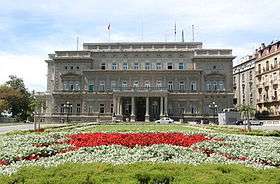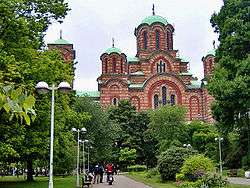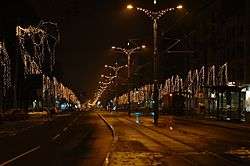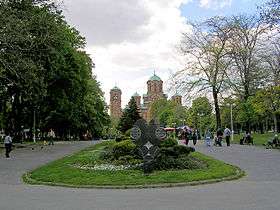Bulevar kralja Aleksandra
| Булевар краља Александра | |
 House of the National Assembly and the headquarters of the Post Office of Serbia, at the beginning of the Bulevar | |
| Former name(s) |
Bulevar kralja Aleksandra (1896–1945) Bulevar Crvene Armije (1945–1952) Bulevar Revolucije (1952–1997) |
|---|---|
| Namesake | Aleksandar Obrenović |
| Length | 7,500 m (24,600 ft) |
| Location | Belgrade |
Bulevar kralja Aleksandra (Serbian Cyrillic: Булевар краља Александра; meaning "King Aleksandar Boulevard" or "Boulevard of King Aleksandar") is the longest street entirely within the urban limits of Serbian capital Belgrade, with length of 7.5 kilometers.[1] Known for decades after World War II as "Bulevar Revolucije" (Boulevard of the Revolution), it is so distinct in the Belgraders' hearts and minds that they simply refer to it as the Bulevar, although there are 20 boulevards in Belgrade.
Location
Due to its length, Bulevar stretches through four out of eight urban municipalities in the old section Belgrade: Stari Grad, Palilula, Vračar and Zvezdara, in which the main part of the Bulevar is located. Starting at the Square of Nikola Pašić, it goes for the most part in a south-east direction, curving only near the end, in the neighborhood of Mali Mokri Lug, after which the Bulevar extends into the road of Smederevski put, which connects Belgrade with the city of Smederevo.[2][3]
History and names
Location of the boulevard was always important for the traffic. In Roman period, it was a starting section of the 924 kilometers long Via Militaris, which connected Singidunum and Constantinople, and in more local terms, Singidunum with fortresses and settlements along the Danube border of the Roman Empire, like Viminacium. Built in the 1st century AD, the road was six meters wide, with rows of shops, forges and arsenals, while Romans were buried along the road in stone sarcophagi. Archeological remnants of the Roman road can still be seen below the “Depo”, former depot of the city’s public transportation company. Majority of boulevard's course is part of the “Ancient Singidunum” archeological locality.[4] In Ottoman period, Turks built a major cemetery in the lower part of the modern boulevard, spreading from Batal mosque (location of the modern House of the National Assembly of Serbia) to Tašmajdan.[4]
In the mid 18th century, route of the Bulevar was a famed Tsarigrad Road (Constantinople road), officially bearing that name to 1849. As population settled along the road, gradually it became a street, originally known as Sokače kod zlatnog topa ("Alley at the golden cannon"). It was later renamed to Markova (Marko's street). The major gunpowder magazine was located in the abandoned and derelict Batal Mosque, but as the town was expanding, the magazine was relocated and the small gunpowder shops were open instead so in 1872 was renamed to Fišeklija, as gunpowder was sold in fišeks, cone-shaped bags made from waxed paper. There was also a large khan next to the mosque.[5] In 1896[4] it was renamed to “Smederevski put” (Smederevo road) and later that year it was renamed after then ruling Serbian king Aleksandar Obrenović, the last from the Obrenović dynasty. Despite being one of the most unpopular modern Serbian rulers, when he was overthrown, new king Peter I Karađorđević from the rival Karađorđević dynasty didn't change the street's name.
Small shops in time evolved into larger facilities, mostly selling old and cheap goods for the poorer citizens. Because of the vicinity of the cemetery in Tašmajdan, there were many shops of funeral equipment and stonecutters. In the 1920s and 1930s, after the cemetery was closed and relocated to the Belgrade New Cemetery and Tašmajdan was gradually turned into the park, so as construction of the Saint Mark's Church and the building of the General Post Office, the road became a proper modern and urbanized street.[6]
In Communist Yugoslavia after World War II, the Boulevard was first renamed "Bulevar Crvene Armije" (Red Army Boulevard) in 1945 and then “Bulevar Revolucije” in 1952. In 1997[4] the name was switched back to its pre-war form.
Sections



The first section of the Bulevar, from its beginning to the crossroads with the Takovska and Kneza Miloša streets, is located in the municipality of Stari Grad. The Bulevar begins from the large fountain on the Square of Nikola Pašić. The entire left side of this section is occupied by the monumental building of the former Assembly of Serbia, while on the right side is the Pioneers Park, and buildings of the Belgrade City Hall and Presidency of Serbia (Andrićev Venac) behind it.
The next section, until the crossroad of Vukov Spomenik, is divided between the municipalities of Palilula (left side) and Vračar (right side). The left side is occupied by the main building of the Post Office of Serbia, Air Serbia terminal, St. Mark's church (declared a cultural monument), Tašmajdan park, famous restaurant "Madera", the University of Belgrade Faculty of Law (work of Petar Bajalović, a culture monument), Metropol Hotel Belgrade, Belgrade University Library and Technical faculties. The residential building at No 63, built in the first decades of the 20th century in the Academism style has been also declared a culture monument. The entire section is declared a "protected complex of Old Beograd".
The right side is mainly residential and commercial, apart from the building of the Embassy of the Czech Republic. Building of the embassy is a place where Yugoslav government signed capitulation to Nazi Germany on 17 April 1941 and during the war itself, the building was diplomatic center for this part of Europe and place from which the dispatches were sent to Berlin.[4] A new ultra-modern commercial building is being built on the corner of Kneza Miloša street, formerly kafana "Tri lista duvana" (Three tobacco leaves). The collective residential building at No 46, built in 1930, is a work of Aleksandar Janković, in the Modernist style. It was badly damaged in Luftwaffe's bombing of Belgrade on 6 April 1941, but later reconstructed and built-on in the 1950s and included into the "protected complex of Old Beograd".
At the crossroad and underground station of Vukov Spomenik begins the Zvezdara section of the Bulevar. It runs through the neighborhoods of Đeram, Lipov Lad, Lion, Zvezdara, Cvetkova Pijaca, Zeleno Brdo and Mali Mokri Lug. This part is mostly residential and commercial, with some important facilities located in the Bulevar: Municipal assembly of Zvezdara, open green markets of Đeram, Cvetkova pijaca and Mali Mokri Lug, "Kluz" clothing factory, roundabout of a dozen buses and tramway lines and industrial zone Ustanička (Electrical industry "Nikola Tesla", "Utenzilija", foundry "Livnica", presses of "Glas Javnosti", etc.).
Characteristics
The oldest still operational sweetshop in Belgrade, "Pelivan", is located in the street, at No. 20. It was founded in 1851 by Mustafa Pelivan, a Gorani from Dragaš. Mustafa gathered the initial capital winning at the wrestling competitions. The original shop was located where the modern Staklenac shopping center is today, on the Plateau of Zoran Điniđić section of the Republic Square. He was succeeded by his son Malić Pelivanović. The shop became quite distinguished by that time: they supplied the Karađorđević Royal Court with halva, Malić was elected a deputy at the National Assembly and Nobelist Ivo Andrić wrote about the pastry shop in "Signs along the road". After his son Azir took over, he educated generations of pastry chefs from all over Serbia. The old shop was destroyed during the German bombing of Belgrade on 6 April 1941, but Azir immediately opened a new one, on the present location. Today, the fifth generation of the family still owns and manages the shop, and the recipe for the famous Pelivan ice cream is still secret.[7]
The Bulevar is one of the most important traffic routes in Belgrade. For the most part it has tram tracks for the city public transportation lines, over 40 public transportation bus and tram lines pass through the sections of the street, and it also contains one of the most important BG Voz stations, Vukov Spomenik. On the other side, despite its length and traffic importance, there are no lines of the third type of city transportation in it: trolleybuses.[4]
Municipality of Zvezdara began an initiative to erect a monument to the King Aleksandar Obrenović somewhere along the street.
A popular Serbian movie named after the Bulevar, "Bulevar Revolucije" was made in 1992. Directed by Vladimir Blaževski, it starred Bojana Maljević and Branislav Lečić.
Depo
The depot was originally built in 1892 as the city's first garage and workshop for the public transportation vehicles. It is the location from which the very first tram in Belgrade, drawn by horses at the time, went on its maiden voyage on 14 October 1892, when the line Kalemegdan-Slavija was established. After World War II it kept its purpose, as a garage of GSP Beograd, the city public transportation company.[4][8][9]
In the 1990s, with the deterioration of the economic system in Serbia and imposed sanctions, the sidewalks of the Bulevar became the gathering place for the street dealers of all sorts of goods that were unavailable in official stores. They were especially known for selling cigarettes, jeans, cookware, flowers, etc. Similar development caught the neighborhood of Zeleni Venac too, and they both became synonymous for the black market during the 1990s. In order to move the illegal sellers from the streets, the city adapted depot into the closed, fair-like shopping center "Depo", with 160 market stalls, in 1996. Sellers were for the most part removed from the street after 2000, selling mostly cloths and cosmetics.[4][8]
The object burned to the ground on 23 August 2014 due to the bad electrical installations. All market stalls, with the complete stocks of all sellers burned. The attempt to relocate the sellers to the Đeram market was unsuccessful as the process dragged for several years and the adapted location ("Depo 2") was deemed inappropriate by the sellers, so they refused to move in and asked for depot to be reconstructed. Out of 80 stalls provided on the Đeram, only 10 are working. Apart from the reconstruction, several other possibilities were mentioned, including the turning of the reconstructed object into the museum of city transport (already proposed in 1996), which was a proposition of the Institute for the protection of the cultural monuments as Depo is under the preliminary protection. In August 2016 city changed the general urban plan and envisioned the commercial facilities, including a hotel, which was a sign that the Depo will not be reconstructed or preserved. On 28 August 2017, mayor of Belgrade, Siniša Mali announced that city decided to sell the entire lot, which covers 4,316 m2 (46,460 sq ft) on which city allows the construction of a commercial-residential complex. The set price is €4 million. Object No. 4, the only one that didn't burn in 2014, has a transformer and a rectifier which still supply the tram's overhead wires. For that reason, the city will retain the authority over the object.[4][8][10][11][9]
Official version of the cause of fire was soon replaced by the rumors that the fire was set on purpose so that lot can be sold. City refuted those stories claiming that Depo will be rebuilt, in one way or another, as personally confirmed by the mayor of Belgrade Siniša Mali a month after the fire. Yet, it was declared an "extra economic zone" and offered for sale. Since the fire investigation had to be concluded in order for city to sell the lot, reporters asked the prosecutor's office for information. In October 2017, the prosecutor stated how investigation concluded that the 3 years old fire wasn't anyone's fault but refused to disclose any documentation saying that it might compromise the process if the office eventually decide to start the investigation again in the future.[12] But on 9 October city announced that the lot was already sold for €4.125 million. The buyer, Israeli company "BKA Development" was registered in Serbia only on 26 September, or less than two weeks prior to the selling of Depo.[13] The "BKA Development" is a joint venture of two Israeli companies, "Yossi Avrahami" and "Almogim Holdings", which already bot the lot of the former US embassy in Belgrade, in the Kneza Miloša street, and was founded with the initial capital of only 100 dinars (€0.83). The constructed object can cover no more than 14,000 m2 (150,000 sq ft) and half of the lot and have a maximum of 6 floors.[9]
Renovations
First phase of a major renovation of the Bulevar started in August 2006. To date first 1.5 kilometers of the street has been completed. The next phase will start as a part of constructing light rail system in 2008.
In February–July 2010, a complete reconstruction of most of the Bulevar was conducted. All installations were replaced, new pavement, sidewalks and traffic lights were constructed. Also, tram tracks were transferred to the center of the street, rather than to be located partially in the middle and partially along the sidewalks. Electrical grid for the trams was aldo replaced and LED lamps were introduced for new LED street lighting.[4][14] However, reconstruction of that magnitude was to include cutting and replacement of the Bulevar’s 2.5 kilometers long avenue which constituted of 423 plane trees. Public outcry resulted in protests and physical obstruction of cutting, so that in some instances police had to intervene. City had to change some of the original plans: they bought more mature seedlings than those they originally planned, they planted 61 trees more than they cut and the modern way of watering the trees is introduced.[4] In the spring of 2014, former city manager Aleksandar Bijelić, and several of his collaborators, were arrested and indicted, in connection with the negotiations for the 2010 reconstruction which cost 1.7 billion dinars (€16.8 million). They are accused of inflicting a damage to the city worth 650 million dinars (€6 million), but as of 2017, there is still no judgement.[4][15]
See also
- List of streets and squares in Belgrade
- BELAM, defunct project
References
- ↑ Politika, April 26, 2008, p. 30
- ↑ Beograd - plan i vodič. Geokarta. 1999. ISBN 86-459-0006-8.
- ↑ Beograd - plan grada. M@gic M@p. 2006. ISBN 86-83501-53-1.
- 1 2 3 4 5 6 7 8 9 10 11 12 Marija Brakočević & Dejan Aleksić (21 February 2016). "Bulevar kralja Aleksandra – moderna avenija sa šarmom prošlosti" (in Serbian). Politika.
- ↑ Dragan Perić (2 September 2018). "Kada su svi putevi vodili u Beograd" [When all roads were leading to Belgrade]. Politika-Magazin, No. 1092 (in Serbian). pp. 28–29.
- ↑ Dragan Perić (21 January 2018). "Ne priliči ministru da drži kafanu" [It's not becoming for a minister to owns a kafana]. Politika-Magazin, No. 1060 (in Serbian). pp. 28–29.
- ↑ Nikola Belić (24 May 2013), ""Pelivanove" poslastice – jače od okupacije, reketaša i tranzicije", Politika (in Serbian), p. 19
- 1 2 3 "Kompleks "Depo" ide na prodaju", Politika (in Serbian), p. 17, 29 August 2017
- 1 2 3 Daliborka Mučibabić, Branka Vasiljević (10 October 2017), "Izraelci kupili bivši "Depo"" [Israelis purchased the former depot], Politika (in Serbian), p. 16
- ↑ Daliborka Mučibabič, Branka Vasiljević, Dejan Aleksić (29 August 2016), "Uz "Depo" i hotel", Politika (in Serbian)
- ↑ Branka Vasiljević (7 September 2017), "Prodaje se izgoreli kompleks "Depo"", Politika (in Serbian), p. 14
- ↑ Jelena Veljković (4 October 2017). "Podaci iz istrage za požar u Depou tajna" [Data from the fire investigation in Depo declared a secret] (in Serbian). Javno.rs.
- ↑ Blic (9 October 2017). "Prodat Depo" [Depo has been sold] (in Serbian). N1.
- ↑ New LED street lights in Belgrade, Beobuild June 16, 2010
- ↑ Dejan Aleksić (18 September 2017), "Gunđalo se i kada su sređivane Nemanjina, "Gazela"...", Politika (in Serbian)
Sources
Route map:
